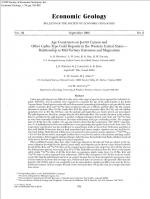Добрый день, Коллеги. Важное сообщение, просьба принять участие. Музей Ферсмана ищет помощь для реставрационных работ в помещении. Подробности по ссылке
Age Constraints on Jerritt Canyon and Other Carlin-Type Gold Deposits in the Western United States— Relationship to Mid-Tertiary Extension and Magmatism
Carlin-type gold deposits are difficult to date and a wide range of ages has been reported for individual deposits. Therefore, several methods were employed to constrain the age of the gold deposits in the Jerritt Canyon district. Dated igneous rocks with well-documented crosscutting relationships to ore provided the most reliable constraints. K/Ar and 40Ar/39Ar dates on igneous rocks are as follows: andesite dikes 324 Ma, sericitic alteration in andesite dikes 118 Ma, basalt dikes 40.8 Ma, quartz monzonite dikes 39.2 Ma, and calc-alkaline ignimbrites 43.1 to 40.1 Ma. Of these, only the andesite and basalt dikes are clearly altered and mineralized. The gold deposits are, therefore, younger than the 40.8 Ma basalt dikes. The sericitic alteration in the andesite dikes is unrelated to the gold deposits. A number of dating techniques did not work. K/Ar and 40Ar/39Ar dates on mica from mineralized Ordovician to Devonian sedimentary rocks gave misleading results. The youngest date of 149 Ma from the smallest <0.1-)U,m-size fraction shows that the temperature (120°-260°C) and duration (?) of hydrothermal activity was insufficient to reset preexisting fine-grained micas in the host rocks. The temperature and duration was also insufficient to anneal fission tracks in zircon from Ordovician quartzites as they yield Middle Proterozoic dates in both mineralized and barren samples. Apatites were too small for fission track dating. Hydrothermal sulfides have pronounced crustal osmium isotope signatures (18'Os/188Osinitiai = 0.9-3.6) but did not yield a meaningful isochron due to very low Re and Os concentrations and large analytical uncertainties. Paleomagnetic dating techniques failed because the hydrothermal fluids sulfidized nearly all of the iron in the host rocks leaving no remnant magnetism.
When published isotopic dates from other Carlin-type deposits in Nevada and Utah are subject to the rigorous evaluation developed for the Jerritt Canyon study, most deposits can be shown to have formed between 42 and 30 Ma. K/Ar and 40Ar/39Ar dates on the youngest preore igneous rocks range from 41 to 32 Ma, whereas the oldest postore igneous rocks range from 35 to 33 Ma. Hydrothermal adularia from the Twin Creeks deposit yields similar 40Ar/39Ar dates of 42 Ma. K/Ar dates on supergene alunite range from 4 to 30 Ma. K/Ar and 40Ar/39Ar dates on micas separated from sedimentary (395-43 Ma) and igneous (145-38 Ma) rocks are usually much older than the gold deposits and most are suspect because they are from incompletely reset preore micas or from mixtures of preore and ore-stage mica. Fission track dates on zircons are also generally older than the deposits (169-35 Ma) and are not completely reset by mineralization. Apatites are likley to be reset by the hydrothermal systems (and by younger thermal events) and yield dates (83-22 Ma) that are younger than those from zircon.
Independent support of a mid-Tertiary age is provided by the low 8DH20 values of hydrothermal fluids from 10 widely separated Carlin-type deposits (-134 ± 23%o). The low 8Dh2o values are consistent with a mid-Tertiary age when the climate was cool but are inconsistent with the Cretaceous and Jurassic ages favored by some workers when the climate was warm. The age and distribution of Carlin-type deposits coincides with areas that underwent extension and calc-alkaline magmatism over the same time period. Despite this relationship, the deposits lack clear spatial or genetic relationships to mid-Tertiary epizonal plutons. Rather, many deposits are localized along preexisting crustal fault zones. In the Getchell trend, structures tapped deep-sourced metamorphic (or magmatic) fluids and subsequently variably exchanged meteoric water. In the other trends and districts only variably exchanged meteoric water has been detected. These relationships suggest either that all of the deposits formed from deep-sourced fluids and were subsequently flooded by meteoric water, or, that fluids from different sources evolved to produce deposits with similar charateristics.




